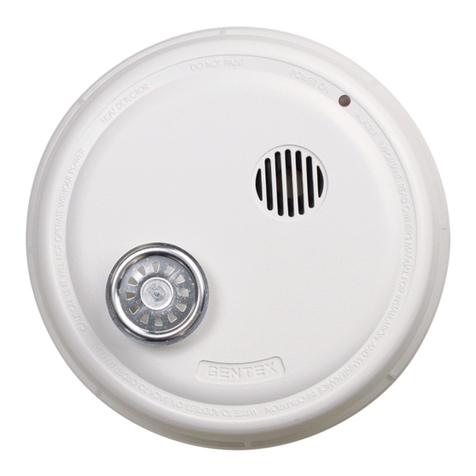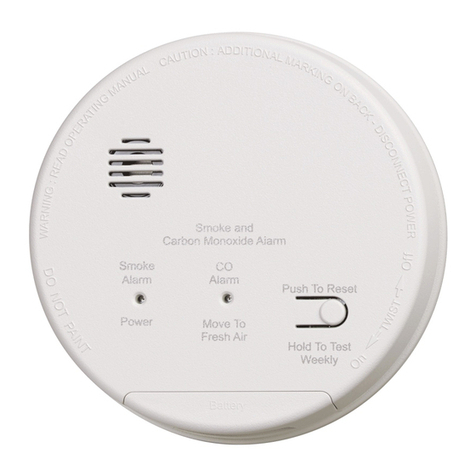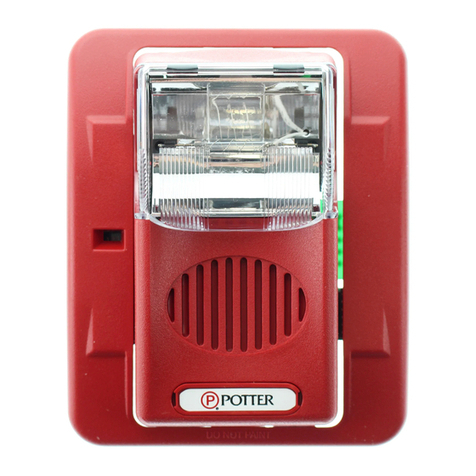
Association recommends that the alarms be interconnected so that an alarm
on any level of the residence will sound an alarm loud enough to awaken
sleepers in closed bedrooms. This can be done by employing a systematic
approach by interconnecting a fire-detection system, by connecting units
together, or by using radio frequency transmitters and receivers.
All types of smoke and heat alarm sensors have limitations. No type
of smoke or heat alarm can sense every kind of fire every time. In
general, alarms may not always warn you about fires caused by violent
explosions, escaping gas, improper storage of flammable materials, or
arson. These types of fires include:
1) Fires where the victim is intimate with a flaming initiated fire; for
example, when a person’s clothes catch on fire while cooking.
2) Fires where the smoke and/or heat is prevented from reaching the
smoke or heat alarm due to a closed door or other obstruction.
3) Incendiary fires where the fire grows so rapidly that an occupant’s
egress is blocked even with properly located smoke alarms and heat
alarms.
NOTICE: T IS EAT ALARM IS NOT DESIGNED TO REPLACE SPECIAL-
PURPOSE FIRE DETECTION AND ALARM SYSTEMS NECESSARY TO
PROTECT PERSONS AND PROPERTY IN NON-RESIDENTIAL BUILDINGS
SUC AS WARE OUSES, OR OT ER LARGE INDUSTRIAL OR
COMMERCIAL BUILDINGS. IT ALONE IS NOT A SUITABLE SUBSTITUTE
FOR COMPLETE FIRE-DETECTION SYSTEMS DESIGNED TO PROTECT
INDIVIDUALS IN OTELS AND MOTELS, DORMITORIES, OSPITALS, OR
OT ER EALT AND SUPERVISORY CARE AND RETIREMENT OMES.
PLEASE REFER TO NFPA 101,T E LIFE SAFETY CODE, AND NFPA 72
FOR SMOKE ALARM REQUIREMENTS FOR FIRE PROTECTION IN
BUILDINGS NOT DEFINED AS " OUSE OLDS."
NOTICE: T IS DEVICE WILL NOT SOUND FOR A CARBON MONOXIDE
(CO) EVENT W EN TANDEM INTERCONNECTED TO A GENTEX CO OR
SMOKE/CO ALARM.
Installing smoke and heat alarms may make you eligible for lower
insurance rates, but smoke alarms and heat alarms are not a substitute for
insurance. omeowners and renters should continue to insure their lives and
property.
HEAT DETECTION
General - NFPA 72 does not require heat alarms as part of the basic
protection scheme, it is recommended that the householder consider the use of
additional heat alarms for the same reasons presented in the next section.
The additional areas lending themselves to protection with heat alarms are the
dining room, attic (finished or unfinished), furnace room, utility room, basement
and integral or attached garage. For bedrooms, the installation of a smoke
alarm is recommended over the installation of a heat alarm for protection of the
occupants from fires in their bedrooms.
Heat Alar Mounting - Dead Air Space. eat from a fire rises to the
ceiling, spreads out across the ceiling surface, and begins to bank down from
the ceiling. The corner where the ceiling and the wall meet is an air space into
which heat has difficulty penetrating. In most fires, this dead air space
measures about 4 inches (0.1 meter) down the wall as shown in FIGURE 6.
eat alarms should not be placed in this dead air space.
The placement of the heat alarm is critical where maximum speed of fire
detection is desired. Thus, a logical location for a heat alarm is the center of
the ceiling. At this location, the alarm is closest to all areas of the room.
If the heat alarm cannot be located in the center of the ceiling, an
off-center location on the ceiling may be permitted to be used.
Per NFPA 72, 2010 29.8.4.3 eat alarms shall be mounted on the ceiling at
least 4 inches (100mm) from a wall or on a wall with the top of the alarm not
less than 4 inches (100mm), no more than 12 inches (300 mm), below the
ceiling.
The Spacing of Heat Alar s. Where a room is too large for protection by a
single heat alarm (50 ft. spacing), several heat alarms should be used. It is
important that they be properly located so all parts of the room are covered.
Where the Distance Between Heat Alar s Should Be Further Reduced.
The distance between heat alarms is based on data obtained from the spread
of heat across a smooth ceiling. Where the ceiling is not smooth, the
placement of the heat alarm should be tailored to the situation.
For instance, with open wood joists, heat travels freely down the joist
channels so that the maximum distance between alarms, 50 ft. (15 m), may be
permitted to be used. owever, heat has trouble spreading across the joists,
so the distance in this direction should be ½ the distance allowed between
d. Bedroom doors should be closed while sleeping if a smoke or heat
alarm is installed in the bedroom. They act as a barrier against heat and
smoke.
WHAT TO DO IF THERE IS A FIRE IN YOUR HOME
If you have prepared family escape plans and practiced them with your
family, you have increased their chances of escaping safely. Review the
following rules with your children when you have fire drills so everyone will
remember them in a real fire emergency:
a. Don't panic; stay calm. Your safe escape may depend on thinking clearly
and remembering what you have practiced.
b. Get out of the house following a planned escape route as quickly as
possible. Do not stop to collect anything or to get dressed.
c. Open doors carefully only after feeling to see if they are hot. Do not open a
door if it is hot; use an alternate escape route.
d. Stay close to the floor; smoke and hot gases rise.
e. Cover your nose and mouth with a cloth, wet if possible, and take short,
shallow breaths.
f. Keep doors and windows closed unless you open them to escape.
g. Meet at your prearranged meeting place after leaving the house.
h. Call the Fire Department as soon as possible from outside your house.
Give the address and your name.
i. Never re-enter a burning building.
Contact your local Fire Department for more information on making your
home safer from fires and about preparing your family's escape plans.
NOTICE: CURRENT STUDIES AVE S OWN SMOKE ALARMS AND EAT
ALARMS MAY NOT AWAKEN ALL SLEEPING INDIVIDUALS, AND T AT IT IS
T E RESPONSIBILITY OF INDIVIDUALS IN T E OUSE OLD T AT ARE
CAPABLE OF ASSISTING OT ERS TO PROVIDE ASSISTANCE TO T OSE
W O MAY NOT BE AWAKENED BY T E ALARM SOUND, OR TO T OSE
W O MAY BE INCAPABLE OF SAFELY EVACUATING T E AREA
UNASSISTED.
WHAT THIS HEAT ALARM CAN DO
This heat alarm is designed to sense heat produced by a fire.
IT WILL NOT SENSE SMO E OR OTHER TOXIC GASES.
When properly located, installed, and maintained, this heat alarm is
designed to provide warning of developing fires at a reasonable cost. This
alarm monitors the air and, when it senses heat, activates its built-in alarm
horn.
NOTICE: T IS EAT ALARM IS DESIGNED FOR USE WIT IN SINGLE
RESIDENTIAL LIVING UNITS ONLY; T AT IS, IT S OULD BE USED INSIDE
A SINGLE-FAMILY OME OR ONE APARTMENT OF A MULTI-FAMILY
BUILDING. IN A MULTI-FAMILY BUILDING, T E UNIT MAY NOT PROVIDE
EARLY WARNING FOR RESIDENTS IF IT IS PLACED OUTSIDE OF T E
RESIDENTIAL UNITS, SUC AS ON OUTSIDE PORC ES, IN CORRIDORS,
LOBBIES, BASEMENTS, OR IN OT ER APARTMENTS. IN MULTI-FAMILY
BUILDINGS, EAC RESIDENTIAL UNIT S OULD AVE ALARMS TO ALERT
T E RESIDENTS OF T AT UNIT. UNITS DESIGNED TO BE
INTERCONNECTED S OULD BE INTERCONNECTED WIT IN ONE FAMILY
RESIDENCE ONLY; OT ERWISE, NUISANCE ALARMS WILL OCCUR
W EN AN ALARM IN ANOT ER LIVING UNIT IS TESTED.
NOTICE: WHAT HEAT ALARMS CANNOT DO
Heat alarms will not work without power. A battery must be connected
to the alarm to maintain proper alarm operation if AC power supply is cut off by
an electrical fire, an open fuse or circuit breaker, or for any other reason. In
the event of AC power failure, the battery will supply power for a minimum of
24 hours.
Heat alarms may not sense a fire that starts where heat cannot reach
the alarms such as in chimneys, in walls, on roofs, or on the other side of
closed doors. Smoke alarms should also be placed in each bedroom as well
as in the common hallway between them.
Heat alarms also may not sense a fire on another level of a residence
or building. For example, a second-floor alarm may not sense a first-floor or
basement fire. Therefore, alarms should be placed on every level of a
residence or building.
The horn in your heat alarm meets or exceeds current audibility
requirements of ANSI/UL 539. owever, if the heat alarm is located outside
a bedroom, it may not wake up a sound sleeper, especially if the bedroom
door is closed or only partly open. If the alarm is located on a different level of
the residence than the bedroom, it is even less likely to awaken people
sleeping in the bedroom. In such cases, the National Fire Protection
550-0158
Pg. D-2


























